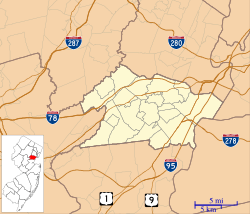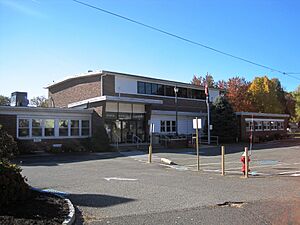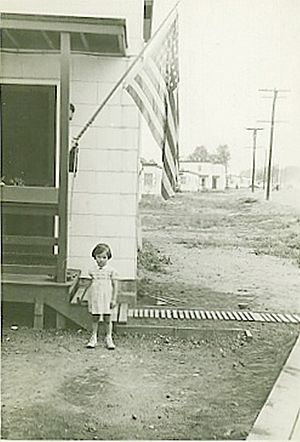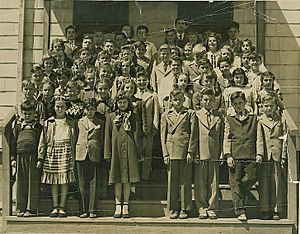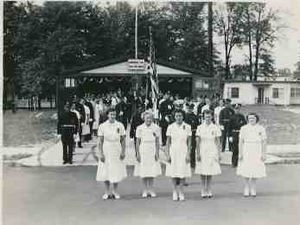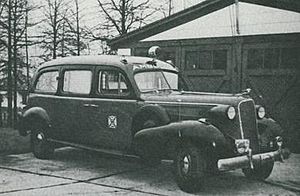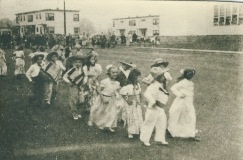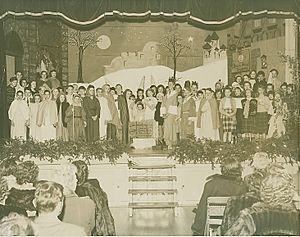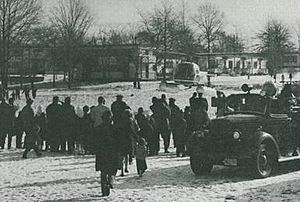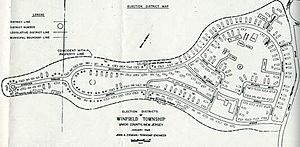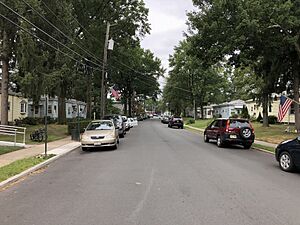Winfield Township, New Jersey facts for kids
Quick facts for kids
Winfield Township, New Jersey
|
||
|---|---|---|
|
Township
|
||

Welcome sign at the intersection of Stiles Street and Winfield Place
|
||
|
||
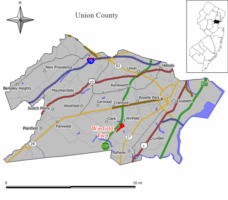
Map of Winfield Township in Union County. Inset: Location of Union County highlighted in the State of New Jersey.
|
||
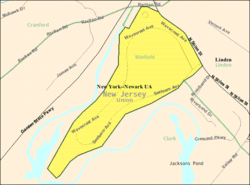
Census Bureau map of Winfield Township, New Jersey.
|
||
| Country | ||
| State | ||
| County | Union | |
| Incorporated | July 28, 1941 | |
| Government | ||
| • Type | Township | |
| • Body | Township Committee | |
| Area | ||
| • Total | 0.18 sq mi (0.47 km2) | |
| • Land | 0.18 sq mi (0.47 km2) | |
| • Water | 0.00 sq mi (0.00 km2) 0.00% | |
| Area rank | 560th of 565 in state 21st of 21 in county |
|
| Elevation | 43 ft (13 m) | |
| Population
(2020)
|
||
| • Total | 1,423 | |
| • Estimate
(2023)
|
1,392 | |
| • Rank | 516th of 565 in state 21st of 21 in county |
|
| • Density | 7,855.0/sq mi (3,032.8/km2) | |
| • Density rank | 53rd of 565 in state 6th of 21 in county |
|
| Time zone | UTC−05:00 (Eastern (EST)) | |
| • Summer (DST) | UTC−04:00 (Eastern (EDT)) | |
| ZIP Code |
07036 – Linden
|
|
| Area code(s) | 908 | |
| FIPS code | 3403981650 | |
| GNIS feature ID | 0882215 | |
Winfield Township (also called Winfield Park) is a small township in Union County, New Jersey. In 2020, its population was 1,423 people. This was a small decrease from its population in 2010. Winfield is one of the smallest towns in New Jersey. It shares a ZIP Code with the nearby town of Linden.
Winfield Township officially became a township on August 6, 1941. It was formed from parts of Clark and Linden. This happened even though the Governor at the time did not approve.
Contents
History of Winfield Township
Winfield Park was originally a housing project for defense workers. It was called the Winfield Park Mutual Ownership Defense Housing Project. It had 700 homes in 254 buildings. These homes were built for workers at the shipyards in Kearny, New Jersey.
This project was the last of eight similar projects. They were all managed by the Federal Works Agency. Winfield Park was first known as the Rahway River Park Project. John T. Rowland was the architect who designed it.
Winfield Park is located near exit 136 of the Garden State Parkway. The towns of Cranford, Linden, and Clark surround Winfield Township. The township itself was created to include the Winfield Park Project. The Rahway River and Rahway River Park border the township on three sides. This makes the area feel very much like a park.
The homes in Winfield Park came in different sizes. There were single-family homes and two-story apartments. Some apartments had two or three bedrooms, like townhouses. Others were one-story apartments with one or two bedrooms.
Within the town, there is an elementary school and a shopping center. There is also a Senior Citizen Hall and a Community Center. The Mutual Housing Office and a garage are also there. The town has a Volunteer Fire and Ambulance Squad Building. There is also a Municipal Building, which includes the Police Office.
Why Winfield Park Was Built
Defense workers from the Kearny Shipyards needed housing. They asked for new homes in northern New Jersey in 1940. These workers strongly supported the National Housing for Defense Act of 1940. This act was also known as the Lanham Act. It helped create the mutual housing program.
In January 1941, a report showed that 1000 homes were needed in the area. The government approved building 300 homes near Newark and Harrison. They also approved 700 homes for a project sponsored by defense workers themselves.
The housing committee had seven main goals for the workers' housing:
- Residents should manage all community affairs.
- Each home should pay local taxes.
- The Federal Works Agency (FWA) would provide streets, sewers, and parks.
- Homes for civilian defense workers should be sold to a local housing company.
- All shareholders in the project should be householders.
- Local companies should manage the project, not the federal government.
- The housing company must sign a sales contract with each householder.
The committee wanted better quality homes than earlier projects. They especially wanted full basements for their new homes.
Choosing the Site for Winfield
The first big challenge was finding a good location for 700 homes. Experts from the United States Housing Authority helped. The New Jersey State Planning Commission also assisted. The land needed to be cheap to buy. It also needed to be close to water, gas, electricity, and sewer lines. The chosen community needed to be financially stable.
Large cities in northern New Jersey were too expensive. Marshy areas near the shipyards were not suitable. The committee then looked at suburban communities. These areas were popular with the workers. However, suburban towns often lacked enough industry to keep property taxes low. People in these towns worried that the new project would cost them money.
Local communities resisted the project. They feared it would be a burden. The housing committee tried to explain that the project would pay real taxes. They also asked Congress for more money for host communities. This money would help expand public services without raising local taxes. But local fears continued.
One worker said that the people moving in were "gainfully employed, law abiding, decent, and respectable." They were not "lower class of people" as some feared.
Seven possible locations were considered. The committee first chose Union Township. But due to strong local and political pressure, they changed their minds. Clark, New Jersey was then chosen. Colonel Lawrence Westbrook of the Federal Works Agency was frustrated. He wrote a letter saying that the protests were not based on facts. He believed Union Township would have benefited from the project.
Clark Township's government had invited the project. But the residents of Clark were not happy about it.
Clark Township Protests the Project
In 1940, Clark was a small, rural town. It had about 350 homes and 1,250 voters. Residents learned about the project at a town meeting on April 1, 1941. A letter from John Carmody, the Federal Works Administrator, was read. He thanked Clark's leaders for their "intelligent and patriotic attitude."
But the residents were not pleased. One local paper reported that people demanded the Township Committee be removed. Residents asked many questions:
- Why was the project kept secret?
- Would the project be permanent?
- Would Clark have to pay for its upkeep later?
- Who would pay for new schools, streets, and police?
- Would the Federal Works Agency promise in writing that the project would not burden Clark?
A lawyer from the Federal Works Agency said they had the power to build anywhere. He did not calm their fears. A worker from the Kearny Shipyards spoke. He said the new neighbors would be "good people." He also said jobs at the shipyards would be stable.
Still, residents were not satisfied. They felt betrayed by their leaders. They formed a group to oppose the project. They wanted to stop the mutual housing project.
Clark residents believed the project would double their local taxes. They thought it would add about 1500 new voters. This would make original residents a minority in local elections. Real estate owners worried the project would lower home prices. The Union County Parks Department was also concerned. They had planned to build expensive single-family homes on that land.
By May 1941, the Clark opposition group had replaced all township leaders. They then focused on stopping the project. They learned from a similar project in Audubon Park. In that case, attempts to stop construction failed in court.
The Clark group came up with a new plan. They would ask the New Jersey State Legislature to make Winfield Park a separate town. If it was a separate town, its residents would pay for their own services. Opponents thought this would make the project too expensive. They believed it would then be canceled. Project supporters said this was an attempt to sabotage the national defense program.
Winfield Township is Created
On June 30, 1941, a bill was introduced to create Winfield Township. The bill quickly passed both the New Jersey General Assembly and the New Jersey Senate.
On July 21, 1941, Governor Charles Edison vetoed the bill. He said it was against the national defense program. He also believed it was unfair to defense workers. He pointed out that it would create a "Federal Island" in New Jersey. The Governor's veto was read to the Legislature on July 28, 1941. Without debate, the Assembly and Senate immediately voted to overturn his veto.
So, on July 28, 1941, Winfield Township, New Jersey, was officially established. Forty Clark Township leaders celebrated in Trenton, New Jersey.
Winfield Township is unique. No other defense housing project became its own town. This created some problems. As one newspaper reported, "Now Uncle Sam owns a town. Uncle Sam cannot tax himself or vote for himself." The residents could not be taxed like regular homeowners. They were promised low monthly charges.
However, becoming its own township allowed residents to control their future. A local newspaper noted that Winfield was now on the official list of municipalities. Its unique challenges also brought the community closer. Residents worked together to form a strong, tight-knit community.
Building the Town
Construction of Winfield Park began on June 23, 1941. The MacEvoy Company of Newark, New Jersey was the contractor. The entire project covered 110 acres and had 254 buildings. It used a lot of materials, like 7500 gallons of paint. It employed 1,223 construction workers for five months.
The work had problems from the start. Labor disputes stopped construction at least once. The MacEvoy Company's work was very poor. An investigation found that the project lacked full building plans. Financial records were also badly kept.
Many new buildings had serious issues. Nails were hammered through water pipes. Chimneys still had wood inside them. Roofs leaked, and water pipes were not properly connected. Floors were uneven, and paint was molding. Sewer lines often did not work. Many roads, sidewalks, and curbs were unfinished. On average, each home needed 37 repairs. The government spent an extra $100,000 to fix these problems. The final cost for Winfield Park was over $4 million. This was much more than the $3,500 limit per unit. Investigations found that the MacEvoy Company had cheated the system.
Life in the Early Community
The construction problems affected early life in Winfield Township. On November 30, 1941, the first 145 families arrived. They were called the "pioneers." They moved into unfinished homes. These homes were often not connected to utilities. Residents huddled around car radios to hear news, like the bombing of Pearl Harbor.
There was no fire protection. The government hired guards with bicycles for "law enforcement." The school was not built yet. Children had to go to schools in other towns. Winfield's neighbors were not friendly to the new residents. Transportation to the Kearny Shipyards was difficult. There was even a polio outbreak, and the town was quarantined.
Despite these difficulties, many people wanted to live in Winfield. The town's population grew quickly. New residents worked at the Kearny shipyards. They also worked at companies like Merck & Company and Singer Manufacturing.
The cooperative nature of the town helped residents bond. The tough early conditions and unfriendly neighbors also brought them together. They formed a strong community. Residents quickly started volunteer police and fire departments. They also created a volunteer Ambulance Squad. A cooperative food store was also established.
Community leaders found out what residents were good at. They used this to create many clubs and social groups. Cooperative child care was provided in a building built by the community. Other projects included a community center and shopping center. A big event was the opening of the town's grammar school on September 8, 1943.
Residents even went on a rent strike against the government. This was to speed up repairs for the poor construction. This strike brought attention to the Winfield Park project.
After World War II
Winfield Park was the last of the Mutual Ownership Defense Housing Projects built. It opened just before the United States entered World War II. It was also one of the last permanent housing projects built for defense. Residents today are proud of how well the buildings have lasted. They have worked hard to repair them.
The Winfield Park Mutual Housing Corporation bought the project from the government in 1950. They paid over $1.3 million. They finished paying off their mortgage in 1984.
A 1966 study described Winfield as a mix of a "cooperative utopia" and a "company town." It noted that the town and the housing corporation were very close. This sometimes led to disagreements between the corporation and the township government.
The study also observed that outside resentment made Winfield residents stick together. If neighbors didn't like Winfield, the feeling was mutual. This also made early settlers wary of all bureaucracy.
Residents have always chosen to keep their mutual ownership concept. They have turned down ideas to sell the community for profit.
In August 2001, the township celebrated its 60th anniversary. They had a community picnic and a parade. The parade was led by Leona Harriot Burke. She was one of the first residents to move to Winfield Park in 1941. She was also the first president of the Volunteer Fire Department's Ladies Auxiliary.
Sociological Research on Winfield
In the mid-1940s, Winfield Park residents were part of a study. This study looked at how people interacted in public housing projects. It was one of the first studies by Columbia University's Bureau of Applied Social Research. It was led by sociologist Robert K. Merton.
Merton was a very important sociologist. He is known as the "Father of the focus group." He also created terms like "self-fulfilling prophecy" and "role model." Winfield Park was called "Craftown" in these studies. It was shown as a community of white, middle-income people. It was often compared to "Hilltown," a racially mixed, lower-income project.
Researchers interviewed residents and observed community meetings. An unpublished manuscript about this research exists. Merton explained that it was not published due to the "Red Scare" after the war. He feared it could harm Winfield Park. Merton saw mutual housing projects as close examples of socialist communities in the U.S. This was a main reason for studying Winfield Park.
Geography of Winfield
Winfield Township is very small. It has a total area of 0.18 square miles (0.47 km2). All of this area is land.
The township is surrounded by other towns. Linden borders it to the north and east. Clark borders it to the south and west.
Population and People
| Historical population | |||
|---|---|---|---|
| Census | Pop. | %± | |
| 1950 | 2,719 | — | |
| 1960 | 2,458 | −9.6% | |
| 1970 | 2,184 | −11.1% | |
| 1980 | 1,785 | −18.3% | |
| 1990 | 1,576 | −11.7% | |
| 2000 | 1,514 | −3.9% | |
| 2010 | 1,471 | −2.8% | |
| 2020 | 1,423 | −3.3% | |
| 2023 (est.) | 1,392 | −5.4% | |
| Population sources: 1950–1990 2000 2010 2020 |
|||
2010 Census Information
In 2010, Winfield Township had 1,471 people. There were 706 households and 382 families. The population density was about 8,320 people per square mile.
Most residents (96.40%) were White. A small number were Black or African American (0.95%) or Asian (0.14%). About 6.39% of the population was Hispanic or Latino.
About 20.8% of households had children under 18. About 39.4% were married couples. The average household had 2.08 people. The average family had 2.83 people.
The median age in Winfield was 42.9 years. About 17.3% of the population was under 18. About 15.8% were 65 or older.
The median household income in 2010 was about $55,323. The median family income was about $61,563. About 7.2% of the population lived below the poverty line.
Sports in Winfield
Winfield is a small community, but it has sports programs. These programs are for elementary school students. They play soccer, basketball, and baseball. The town also has a year-round recreational sports program.
Education in Winfield
The Winfield Township School District serves students from pre-kindergarten to eighth grade. All students attend Winfield School. In the 2018–19 school year, the school had 139 students. There were 18 teachers. This means there were about 7.7 students for every teacher. Winfield School also has a class for students with special needs.
For high school, students attend David Brearley High School in Kenilworth. This is part of a special agreement with the Kenilworth Public Schools. In 2018–19, David Brearley High School had 757 students.
Students in grades 9-12 can also attend the Union County Vocational Technical Schools. These schools are located in Scotch Plains.
Transportation
Roads and Highways
As of 2010, Winfield Township had 3.10 miles of roads. Most of these roads (3.00 miles) were maintained by the town. A small part (0.10 miles) was maintained by Union County.
North Stiles Street (County Route 615) is on the northeastern edge of Winfield Township. A small part of Raritan Road (County Route 607) forms the northern border.
The Garden State Parkway is very close to Winfield. It is about 100 yards away. You can get on it at Exit 136, which is on the border of Cranford and Clark.
Public Transportation
NJ Transit offers bus service. Route 112 goes between Winfield and the Port Authority Bus Terminal in Midtown Manhattan. Local bus service is available on routes 56 and 57.
Train service is available nearby. You can catch a train from Cranford on the Raritan Valley Line. You can also use the Linden station on the Northeast Corridor.
Newark Liberty International Airport is about 12 minutes away. It is located in Newark and Elizabeth. Linden Airport, a smaller airport, is in Linden.
Notable People from Winfield
People who have lived in or are connected to Winfield Township include:
- Tom Dugan (born 1961), an actor who appeared in the music video for Legs by ZZ Top.
- Dan Graham (born 1942), a conceptual artist and art critic.
- Jeffrey Moran (born 1946), a former member of the New Jersey General Assembly.
See also
 In Spanish: Municipio de Winfield (Nueva Jersey) para niños
In Spanish: Municipio de Winfield (Nueva Jersey) para niños



